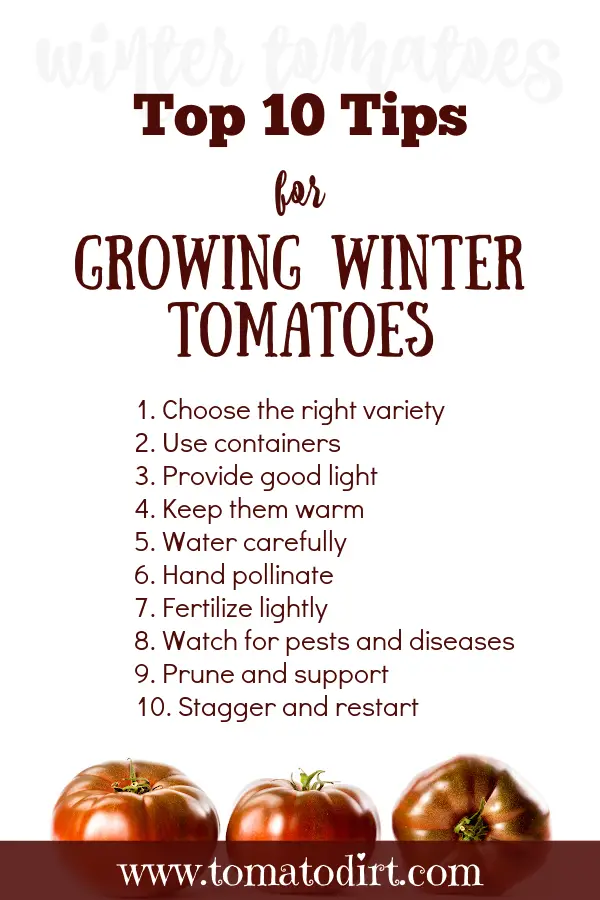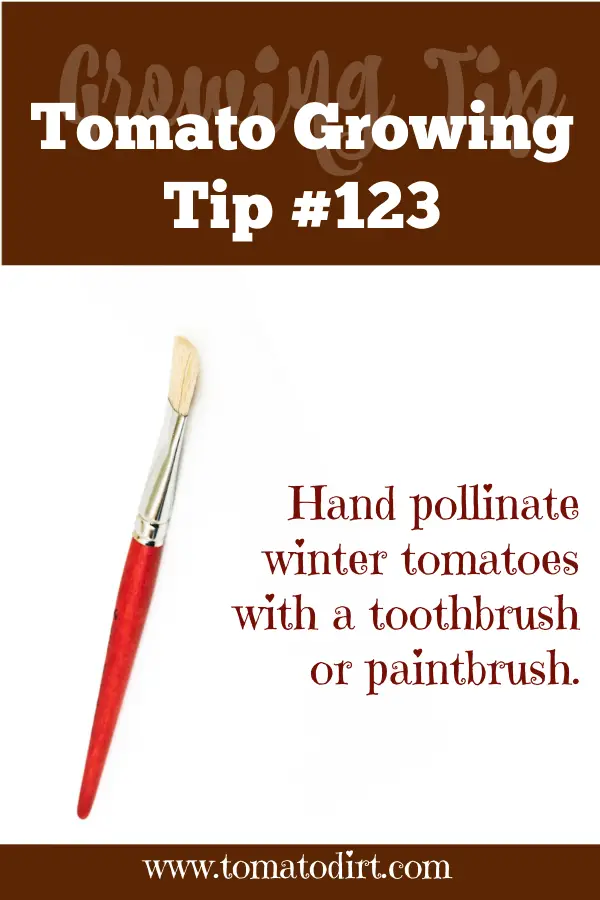FREE: 10 Must-Know Tomato Growing Tips Get The Guide
Read our affiliate disclosure here.
Growing Winter Tomatoes:
Top 10 Tips
Since 2010, Tomato Dirt has garnered 4.8+ million views, making it the web’s leading online source for growing tomatoes in the home garden. Award-winning writer and Tomato Dirt owner Kathy Widenhouse has helped thousands of home gardeners grow healthier tomatoes. Be one of them when you get Tomato Dirt’s Growing Guide here.
Posted 12.1.25
The end of the outdoor growing season does not mean you must stop enjoying fresh produce.
Growing winter tomatoes takes a little planning and the right setup — but it’s absolutely possible.
You have 3 options to choose from: grow winter tomatoes indoors, in a greenhouse, or in a cold frame.
Each setup has specific methods you can use to ensure that a bumper winter tomato crop. But regardless of which one you choose, there are basics to follow. Here are the top tips for growing winter tomatoes successfully.
Top 10 tips for growing winter tomatoes
1. Choose the right variety
- Winter tomato success begins with cold-tolerant tomatoes or varieties that are suitable for indoor cultivation. Look for ‘Siberian’, ‘Glacier’, ‘Stupice’ – short-season, cold-tolerant types. ‘Tiny Tim’, ‘Red Robin’, and ‘Totem’ are dwarf or patio varieties perfect for containers and indoor growing.
- Cherry tomatoes generally perform better than large-fruited types in low light.
2. Grow winter tomatoes in containers
Containers let you move plants to chase the best light and warmth. Use 5-gallon pots or larger for indeterminate varieties, or 1–3-gallon containers for dwarfs. Make sure your containers have excellent drainage and use a light, rich potting mix (avoid using garden soil indoors).
3. Provide plenty of light
- In the best circumstances, tomatoes need 12–16 hours of light per day --- make that 14-18 hours in the weak sunlight. When you’re growing winter tomatoes, consider supplementing natural light with grow lights. Natural winter light is less intense than full sun during the peak summer months.
- Use full-spectrum LED grow lights placed about 6–12 inches above the plants.
- If you’re using window light, rotate the plants every few days so they grow evenly.
4. Keep winter tomato plants warm (but not too warm!)
- Tomatoes flourish in day temperatures of 70–80°F and night temperatures around 60–65°F. They stop thriving below 55°F (13°C).
- Avoid drafty windows — cold nights can shock the plants and cause blossom drop. A seedling heat mat or small space heater with a thermostat can stabilize temperatures in a greenhouse or sunroom.
5. Water carefully
In cooler months, tomato plants grow more slowly. That means they use less water. Keep the soil evenly moist but not soggy — overwatering leads to root rot and fungus gnats. Use room-temperature water to avoid chilling the roots.
6. Hand pollinate to help set the fruit
Indoor plants won’t have bees, breezes, and birds to spread pollen, so you need to help them out. When tomato plants bloom, gently shake the flowers or use a small paintbrush or electric toothbrush to transfer pollen. You can also try a small oscillating fan. “Pollinate” the blossoms daily when plants are flowering to encourage fruit production.
7. Fertilize lightly but regularly
- Feed your winter tomatoes every 2–3 weeks with a balanced tomato fertilizer, such as a 10-10-10 or 5-10-10.
- Once flowering begins, switch to a low-nitrogen, high-phosphorus formula to boost fruiting, like Tomato Tone or Miracle-Gro Tomatoes.
- Pitfalls to avoid: Don’t overfertilize — it promotes leaf growth instead of fruit. And stop feeding if growth slows due to low light. You’ll recognize that problem when leaves turn yellow. Give plants a chance to catch up.
8. Watch for pests and diseases
Indoor air can attract aphids, whiteflies, or spider mites. Spray your plants with neem oil or insecticidal soap as soon as you see signs.
Maintain good air circulation with a small fan to prevent fungal diseases.
9. Prune and support your winter tomato plants
Even small plants need airflow and light. Remove suckers and lower leaves that are touching the soil. This will help prevent diseases from spreading and give your plant room to grow.
Use small tomato cages, bamboo stakes, or clips to keep plants upright and prevent breakage.
10. Stagger or restart plants
Start new seeds every 8–10 weeks for continuous harvests through winter. Indoor tomato plants often decline after 3–4 months, so refreshing your crop keeps production steady.
Bonus tip for growing winter tomatoes
Maximize your crop when you take cuttings from your healthy plants, root them in a glass of water, and then plant the new seedlings.
With just a little bit of effort, you can enjoy growing winter tomatoes throughout the cold months.
More on Growing Winter Tomatoes
How to grow winter tomatoes: 3 options ...
How To Protect Outdoor Pots in Winter ...
How to grow indoor tomatoes ...
Growing indoor tomatoes FAQs: Frequently Asked Questions...
How to grow cherry tomatoes indoors all year long ...
Tomato grow lights explained ...
Can I grow tomatoes in a greenhouse? FAQs and tips ...
Use Cold Frame for Gardening All Year Long ...
See more tips on our Indoor Tomatoes Pinterest Board...
Return from Top 10 Tips for Growing Winter Tomatoes to Tomato Dirt home
As an Amazon Associate and Rakuten Advertising affiliate I earn from qualifying purchases.
SHARE THIS PAGE:
FREE! 10 Must-Know Tomato Growing Tips: 20-page guide
Get yours here:





